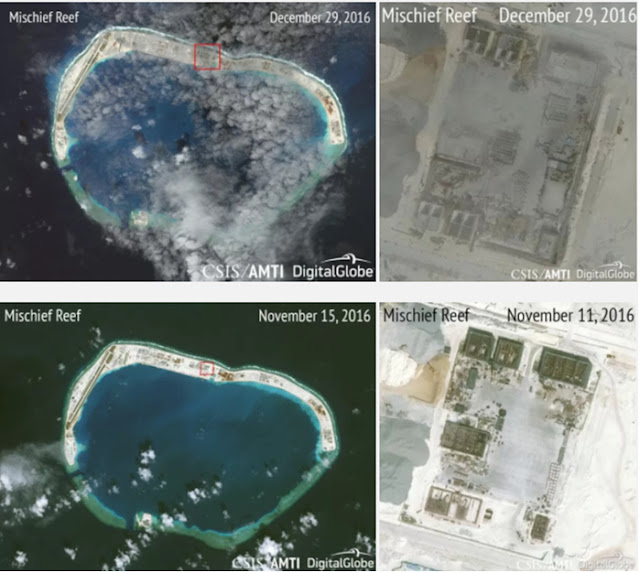China says Australia disrupting 'stability and peace' in South China Sea; build-up on islands continues
China 'continues to build in South China Sea'
China's Navy chief has told his Australian counterpart that Australian actions in the past year have "run counter to the general trend of peace and stability" in the disputed South China Sea, according to China's state media.
Key points:
- Navy chief Shen Jinlong didn't mention specific incidents but says Australia is disrupting stability in the region
- The meeting comes as a US-based think-tank releases photographs of building in disputed islands
- China claims the entire maritime area, which Vietnam and the Philippines contest
Navy chief Shen Jinlong told Vice Admiral Tim Barrett on Thursday in Beijing that Australian and Chinese naval ties have had stable development, but raised concerns about "a series of Australian Navy actions".
According to Chinese media reports, the main Australian action China objected to was the deployment of 6 naval ships carrying 1,200 personnel to take part in the three-month Indo-Pacific Endeavour exercises."The Chinese side is very concerned why Australia would join 10 other countries to choose the South China Sea to undertake this drill, and the intention behind it," the article said.
The report quoted Vice Admiral Barrett as saying the drills were normal and long established, but said he didn't explain why an area of the South China Sea was chosen.
Australia's Navy hasn't issued comment on the dialogue, which came during a time of heightened tension between Australia and China.
China's foreign ministry confirmed it last week summoned Australia's Ambassador to Beijing, Jan Adams, to make Chinese concerns clear over the political rhetoric surrounding the Turnbull Government's new counter espionage laws.
China's state-controlled media has also run a series of hard-line, and at times sensationalist, editorials claiming Australia's Government and media is stirring up anti-Chinese sentiment.
Australia's Navy has previously carried out aerial patrols in the South China Sea, but has not joined the United States in freedom of navigation patrols on the water.
In November Foreign Affairs officials from Australia, India, Japan and the US also met for the first Quadrennial security dialogue in a decade, a grouping that Beijing views as seeking to contain China.
The criticism from the Chinese Navy coincided with the release of an annual report from a US-based think tank detailing new Chinese structures on disputed South China Sea islands.
According to the Washington-based Asia Maritime Transparency Initiative (AMTI), China added 290,000 square metres of facilities on disputed reefs this year.
"These include buildings ranging from underground storage areas and administrative buildings to large radar and sensor arrays," the AMTI report said.
The report, based on satellite images, finds that China mostly completed the dredging and landfilling work on seven man-made islands last year, but has this year continued building permanent "infrastructure necessary for fully-functioning air and naval bases".
The most construction was carried out on Fiery Cross reef, also claimed by the Philippines, Vietnam and Taiwan.
According to the AMTI, larger hangars along the airstrip, new underground storage, radar and sensor installations and hardened shelters for surface-to-air missile platforms were built on the base during the past 12 months.
Earlier this year China and the Association of South-East Asian Nations (ASEAN) agreed to a negotiating framework for a code of conduct in the vitally strategic waterway.
China's Government hasn't said whether any code, if it eventuates, would be legally binding.
Critics see the diplomatic negotiations as a delaying tactic to allow China to complete its militarisation program.
Last year an international court in the Hague invalidated the legal basis for much of China's island reclamation work, without making any ruling on the territorial disputes themselves.
A previous Philippines government launched the long-running legal case, the result of which has largely been cast aside by the current administration of Rodrigo Duterte in favour of better economic and diplomatic ties with Beijing.
In October this year, China's President Xi Jinping publicly hailed the progress of construction of islands and reefs in the South China Sea when outlining the country's biggest achievements of the past five years.
China claims almost the entire South China Sea, and says the islands have both civilian use and "normal defence facilities".


Comments
Post a Comment